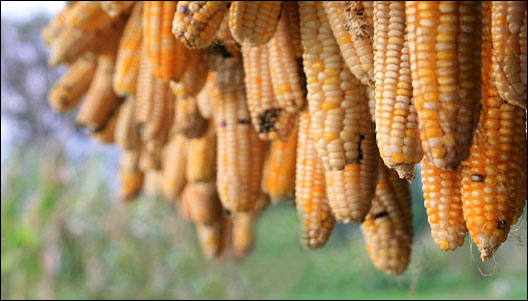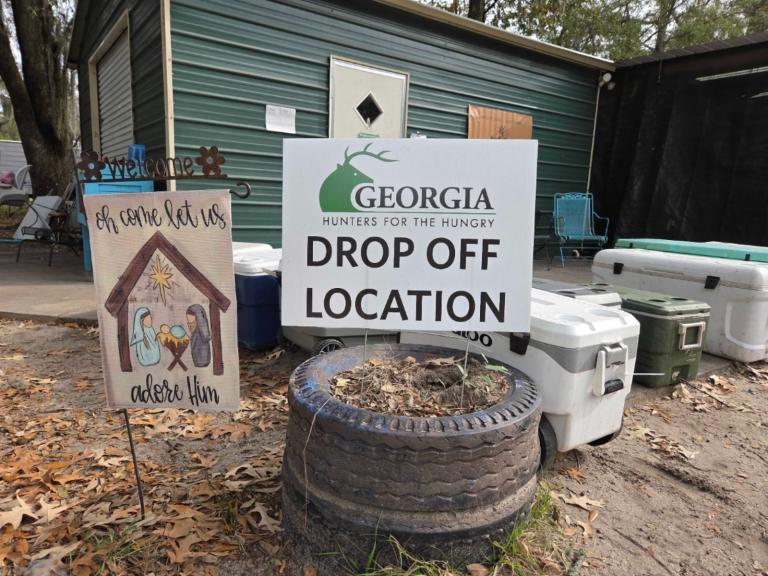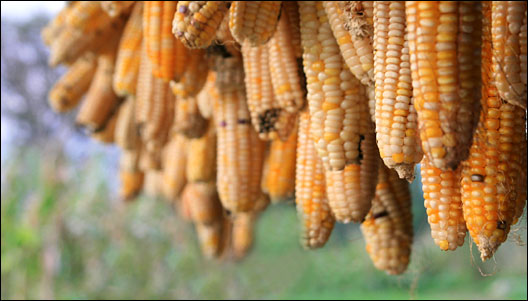
In Mexico, a milpa is a garden patch, usually kept by several families, to grow a substantial portion of a year’s sustenance. Milpas are typically dominated by corn — first domesticated in present-day Mexico thousands of years ago — but also contain stunning agricultural and nutritional diversity.
In addition to corn for tortillas, traditional milpas grow squash and beans of many varieties, avocados, melon, tomatoes, chile pepper, sweet potato, jicama, amaranth, and a medicinal herb called mucana, claims journalist Charles C. Mann in his 2005 book 1491: New Revelations of the Americas Before Columbus. “Milpa crops are nutritionally and environmentally complementary,” Mann writes. “Maize lacks the amino acids lysine and tryptophan, which the body needs to make proteins and niacin … Beans have both lysine and tryptophan … Squashes, for their part, provide an array of vitamins; avocados, fats.” Agriculturally, beans fix nitrogen from the air into the soil, helping fertilize corn, which requires large amounts of nitrogen. Quoting H. Garrison Wilkes, a biologist at the University of Massachusetts in Boston, Mann calls the milpa “one of the most successful human inventions ever created.”
The great invention is increasingly marginal to modern Mexican life. The Revolution-era land-reform programs that once gave rural life a measure of stability have been gutted over the past 20 years. Promising a manufacturing boom and a new era of prosperity, Mexico’s leaders beckoned campesinos (smallholder farmers, mostly ethnically indigenous) from the countryside into the cities. The boom never quite materialized, at least not in powerful enough form to provide sufficient jobs for the rural exodus. As a result, the country now has a devastated rural economy and swelling shanty towns on the edges of its cities, housing millions of workers in the “informal economy” (i.e., chewing gum salespeople, windshield washers, etc.). It has also, of course, exported millions of excess farmers north of the border, where they staff our farms, meatpacking plants, restaurant kitchens, and construction sites.
I’ve been traveling to Mexico for years now. I lived in Mexico City in from 1997 to 1999, working first as an English teacher and then as a financial journalist. This summer I went back, spending several weeks in central Mexico tagging along with my girlfriend, a PhD student on a research trip. I spent most of my time keeping up with my duties for Grist, but I did get to accompany her on some of her research endeavors.
In my time there, I began to think of milpas — those teemingly diverse garden patches — as a metaphor for a country in which several worlds seem to coexist in the same time and place. And also as a way forward at a time of stagnant economic growth and rising food prices.
Among Wal-Mart Supercenters and Tlacoyo Stands
In the Mexico that I know, food is a hodgepodge. Industrial food abounds. When I lived in Mexico 10 years ago, Wal-Mart was just dipping its toe into the market. Today, its Mexico subsidiary is the nation’s largest private company after the state-run oil giant Pemex, and its largest employer. Between Wal-Mart Supercenters, Sam’s Clubs, and its supermarket chain Superama, Wal-Mart is by far the nation’s largest grocer, its shelves crammed with the same convenience food you find in the states. On this last trip, I was deflated to find Mexico City dotted with Starbucks outlets, boasting African coffee in a country that produces plenty of fantastic coffee itself. U.S. fast-food chains, which seemed concentrated in tony malls when I lived there before, now seemed much more present. They hawk 10-peso ($1) menu items — which, as prices rise for traditional tortilla-based fare, is an increasingly competitive price.
And yet, if Mexico’s food culture is rapidly industrializing, it retains plenty of its old vigor. Hulking Wal-Marts may now dot Mexico City and much of the country, but I’m happy to report that the city still boasts well-trafficked neighborhood markets offering a dizzying cornucopia of unprocessed fruits, vegetables, beans, and meats, as well as delicious, traditional cooked fare. And the street food remains one of the city’s great jewels. In our time in Mexico City during this last trip, we largely sustained ourselves on the tlacoyos from a stand across the (extremely busy) street from our apartment.
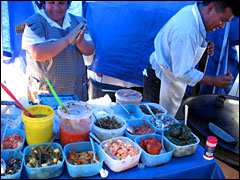
Delicious tlacoyos on the Mexico City street.
Photo: Tom Philpott
Not visibly different from literally hundreds if not thousands if similar stands across the city, this one served some of the best food I’ve ever had. Tlacoyos are oblong pancakes made of masa — the same ground corn paste that makes up tortillas — and stuffed with refried beans before being toasted on a griddle. When you order one, you specify which guisado (cooked topping) you want. This stand offered several meat guisados, which I avoided in my general campaign to steer clear of meat whose provenance I don’t know. Instead, I stuck to tangy nopales (chunks of cooked cactus); earthy, deep-flavored huitlacoche (a mind-blowingly delicious fungus that colonizes corn cobs); quelitas (a sauteed, spinach-like green known in the United States as lamb’s quarters); and rajas con papas (strips of roasted poblano chiles sauteed with potatoes). Once toasted, tlacoyos are topped with a guidsado, dusted with grated hard cheese, and drizzled with a spicy salsa (red or green). Each one cost 10 pesos (the same as a fast-food burger), and two is a filling breakfast. My stomach rumbles just thinking of them. Every time I went there, no matter what time of day, there were at least three or four diners huddled around the stand, sitting at small plastic chairs, savoring these little masterpieces.
Next to that tlacoyo stand, a woman ran a small vegetable stand focusing on traditional, milpa-grown fare. She had laid out piles of beautiful wild mushrooms, nopales, huitlacoche, purlsane (a highly nutritious weed), and several other things I couldn’t identify.
Within three blocks of this little bubble of glorious food is a giant mall containing a Starbucks, a Ben & Jerry’s, and an Olive Garden-like Italian chain restaurant; two U.S.-style supermarkets; and an old-school food market. Like most of central Mexico City, all of those disparate spaces pulse with locals. Munching fast food at the mall food court over a latté is just as “authentic” as getting down with a bowl of pozole — a delectable, chile-laced corn stew — in the market. But unlike in the United States, where by a generation ago most interesting food traditions had been paved over, Mexico still has plenty to lose — and much worth preserving.
Toward New Milpa Traditions
If Mexico City showed me how Mexico’s culinary past interacts with a highly industrialized version of a culinary future, I found new visions of that interaction in Guadalajara, a city of 1.6 million people a few hours northwest of the capital.
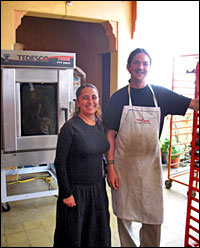
Eva Robles and Pepe Godoy at Pan Arte
in Guadalajara.
Photo: Tom Philpott
There, I met Eva Robles and Pepe Godoy of La Coa Collective — a group on the avant-garde of Mexico’s version of the local-food movement. (Coa is a kind of pointed hoe used by pre-Colombian farmers.) Godoy runs the small artisinal bakery Pan Arte in downtown Guadalajara; it wholesales to local restaurants and cafés. The bakery, along with a separate cafe project, funds La Coa’s activist work, which is to defend the land rights of campesino smallholders against the claims of wealthy landlords. Robles, a trained lawyer, spearheads that task. Coa is also active in Defensa de Maiz, a broad-based movement to protect the biodiversity of Mexico’s corn agriculture against encroachment from the large agribusiness firms that increasingly control the country’s corn trade.
La Coa Collective also keeps a small milpa just outside of the city, in a lush area under tremendous pressure from suburban-style development. One afternoon, they took me out to see the milpa. Since they’re extremely busy urban folks — in addition to their more-than-fulltime jobs, they also have a rambunctious 2-year-old son — I wasn’t surprised to see the milpa overgrown with weeds. Showing none of the guilt and shame that mark my own farming efforts when things get out of control, Robles and Godoy calmly got down to work, enlisting me and my travel companions in the effort to weed the beds.
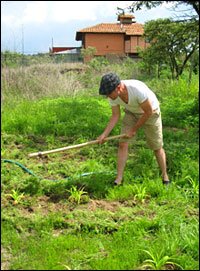
Getting busy in a milpa, outside of Guadalajara.
Some of us hand-weeded around the plants while others came behind to cultivate with a hoe. They had sown squash and beans along with the corn in the time-tested milpa style. A bit of weeding showed that the squash and bean crops had largely failed, but healthy corn shoots poked through the dry, unirrigated dirt, struggling for sun amid the bramble. The whole patch was less than a quarter of an acre, and with all of us working, it didn’t take long to liberate a big chunk of the fields from the weeds. It would be the last weeding they’d need to do; the corn would soon grow tall enough to out-compete new growth.
I asked Godoy what sort of yield he expected. He told me the patch would yield enough corn to provide the four-adult collective with tortillas for year — an impressive yield for a small piece of unirrigated land that doesn’t require much active attention. I wondered how the recent jump in corn prices had affected small farmers in Mexico. Godoy said that most of them were shut out of commodity markets and thus didn’t see much benefit from the boom. But he added that with tortilla prices on the rise, more and more people are putting in milpas.
I remembered, on the bus ride from Mexico City, patches of corn poking out here and there from densely populated shanty towns.
In a country as large and complex as Mexico, there is no big-A Answer to the many problems of poverty and food insecurity. But there are many small-A answers, just as Mexico City contains a multitude of worlds at once, just as a healthy milpa teams with all manner of life.
